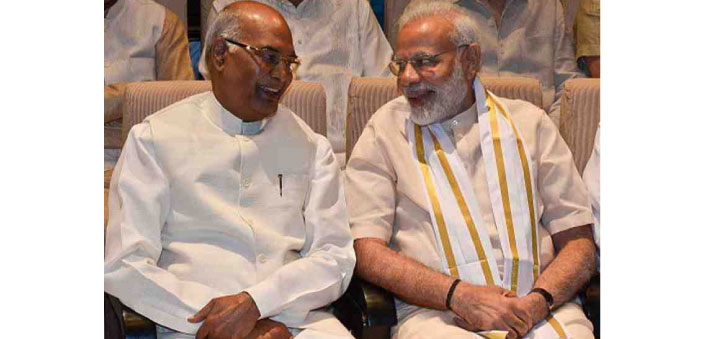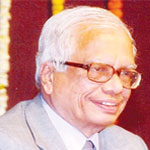The 14th President of India was elected by the Members of Parliament (MPs) and elected members of the state legislatures on 17th July, 2017. The Election Commission of India (ECI) that is charged by the Constitution to organise elections declared on 20th July, 2017, that Ram Nath Kovind, the National Democratic Alliance (NDA) candidate was President-elect. He defeated United Opposition of India Parties (UOIP) candidate, Meira Kumar. It was well-known that NDA had numerical strength to get him elected. He secured 65.65 percent votes, while Meira Kumar gained 34.35 per cent. Hence, the ECI announcement was only a legal and public confirmation of a foregone conclusion.
The new President was sworn in by the Chief Justice of the Supreme Court on 25th July. Since we Indians, are blessed with a Republic, literally any one can aspire to be the President. Under the Constitution of India, a few qualifications are needed to be the President. From the point of view of this piece, first, he (wherever he is used, invariably it also means she), is to be a citizen of India. Unlike the American Constitution, it doesn’t prescribe him to be a ‘natural born’ citizen. In an immigrant society, Americans were suspicious of a new immigrant trying to become president. Second, he ought to be 35 years of age, and third, he needs to possess qualifications prescribed to be elected as a member of the Lok Sabha.
Selective qualifications
There is thus, obviously, no academic qualifications prescribed; as an example, the late Gyani Zail Singh, though a non-matriculate, became the President of India. According to Indira Gandhi’s Private Secretary, P.C. Alexander, Indira Gandhi chose him for his loyalty to her; he had publicly said that if she asks him to sweep the floor, he would ungrudgingly do it. Additionally, as she was then facing a political crisis in Punjab, making a Sikh President, she thought, would help her to overcome that community’s anger against her caused by Operation Blue Star to flush out terrorists holed up in Amritsar’s Golden Temple.
On the other hand, there have been scholarly persons like Dr. Rajendra Prasad, S. Radhakrishnan, or Zakir Hussein, R. Venkataraman and a few others. In recent times, the late Dr.A.P.J. Kalam was not only a humane, highly qualified and a scholarly man, he turned out to be a popular, and literally, the peoples’ president.
Now that Kovind is elected president, what considerations might have gone into his selection as a presidential candidate? What has dominated the decision making is, ‘How does his selection further promote political agenda of the party in power?’ The ruling BJP during its first journey into power in the 1990s rode into power on the Hindutva horse! But now it’s Sabka saath, sabka vikas. This has appealed to a large number of people in the country. Vikas does not occur overnight. Yet, at least PM’s three programmes –Jana Dhan Yojana, Swachh Bharat, and Ujwala among others have caught the imagination of not only beneficiaries, but even political observers who have appreciated it. Hence, even though Muslims in the country, especially in the last Uttar Pradesh elections have voted for the BJP, it is the constituency of Dalits and the Most Backward Communities (MBCs) that the BJP would like to make a part of its broad national base.
However, it is not the first time a Dalit has been chosen to be the President. Congress had chosen a diplomat close to Nehru-Gandhi family, as Vice-President in 1992. In 1997, the then ruling United Front (UF) government headed by the Prime Minister H. D. Deve Gowda, though consisted of 13 political parties did not enjoy enough strength in the Lok Sabha; hence, had to depend on external support from the Congress and the Communist Party of India (Marxists) to survive in power. Real tragedy then was no one, not even Marxist leader Jyoti Basu could exactly know, according to his confession, how many parties and factions supported the government!
Yet, each faction and party was pushing for its own candidate based on caste, religion and region etc. Deve Gowda wanted then Karnataka Governor, Khurshid Alam Khan. Under those circumstances, finally they agreed to convert then Vice President’s candidature of K.R. Narayanan for the President’s post. I am sure a majority of conscious citizens would have thought him as a diplomat and an educator. But the moment he was nominated to the Presidential post, it was advertised that he was a Dalit! A national figure was reduced to the stature of a sectional candidate!
Hence, today when the Congress party criticises the BJP for using the Dalit factor, it is a case of the kettle calling the pot black! Isn’t it a fact that the Congress party chose Meira Kumar to demonstrate not only that its own candidate is a Dalit, but was also a better qualified Dalit with higher political lineage, as a plus point? The situation was salvaged by Meira Kumar herself by repeatedly stating that it was not a contest between Dalits but an ideological contest!
Regional considerations have been always important; hence having selected a northerner in Kovind, PM Modi being from west, has chosen Venkaiyyah Naidu for instance, a southerner as the next Vice-Presidential candidate. These considerations are not unique to India, but can be seen in all democracies. In the US, a northern candidate, for instance, John F. Kennedy, chose Lyndon Johnson, a southerner as a vice presidential choice, or last year, Donald Trump, a northerner, chose a midwesterner, Mike Pence, as a vice-presidential running mate.
There was also a mention that, this is the first time a RSS man and a BJP member has become the President. Undoubtedly, Kovind has been silent but has hard core supporters of both these organisations. That is evident from the fact that he has gifted his ancestral home to the RSS. He has been a staunch supporter of the BJP, having joined it in 1991, soon after he contested on the BJP ticket in Ghatampur assembly in the UP, but lost it. Again in 2007, he tried his luck in UP’s Bognipur. He didn’t resign to join another party if he had lust for power.
Hence, his loyalty to the party and work as the convener of the BJP Dalit Morcha, won him a seat in the Rajya Sabha, where he spent two terms between 1994 and 2006. He also had been a sitting Governor of Bihar for three years just before filing his nomination. This background testifies his sufficient exposure to politics and administration! The PM had also known him for the last 20 years; that is expected to help to maintain cordiality between the PMO and Rashtrapati Bhavan.
Conclusion
The election of Kovind is a great event in Indian contemporary history, seen from any perspective. Seen from the perspective of the BJP, election of a party loyalist as Indian President for the first time is a major milestone for it in its development chart. Personally, for PM Modi getting him elected might help him to maintain cordial relations with him. But to expect that could always remain like that in future is an extremely difficult proposition. For instance, in a reverse case, Zail Singh gave PM’s post to Rajiv Gandhi, as his loyalty bonus to Indira Gandhi; but later their relations got into troubled waters because of mutual suspicions. Zail Singh refused to sign the Indian Post Office (Amendment) Bill in 1986, which the President thought could lead to censoring personal mail. Zail Singh had even toyed with the idea of dismissing the Rajiv government! It is not uncommon for friends to become foes and foes to become friends in politics.
Personally for Kovind, from a mud-house to the Rashtrapati Bhavan is the equivalent of Abraham Lincoln’s story of ‘Log House to White House’. Villagers from Kovind’s birth place have already expressed their hopes for vikas (development) of their village! That may happen, but will dalit-s be liberated all over India? For that he may have to make dalit-s wait till the nation moves to embrace a Presidential system – in other words, he moves from a Titular Presidency to an Executive Presidency! Somewhat similar to Lincoln liberating the African-Americans from slavery, though he himself was neither an African-American nor a slave! Ironically, there lies a lesson: Dalit liberation doesn’t need a dalit in power!


 [/column]
[/column]